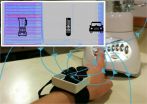The sensor is simple to use and it can detect tiny amounts of contamination in water, making it more sensitive than existing detection methods. The authors of the study, from Seoul National University, say this could make the technology even more useful in the field.
There are two main problems caused by bacteria and other microbes in water: they can make the water toxic, and make it smell bad. At high concentrations, bacteria can be toxic in drinking water. But at lower levels - virtually undetectable by current culturing techniques - they can cause an "off flavor," putting people off from drinking it.
The new study shows how technology that mimics the human nose can sniff out low levels of bacteria and other microbes by detecting the off flavor they give off.
"Water that smells bad isn't necessarily toxic," said Professor Tai Hyun Park, who has been leading the study. "Imagine you don't do your laundry; it's not that toxic but you don't want to wear it because the smell is bad. With drinking water, if there's off flavor, even if the water isn't toxic, you don't want to drink it. We wanted to develop a way to detect and remove this kind of contamination, so people are happy to drink water."
Traditionally, water was tested for contamination with bacteria by taking a sample and trying to grow the bacteria in the lab. When the bacteria grow, scientists can count the number of colonies and calculate the concentration of bacteria in the water. Another approach is to detect the smells directly; this is usually done using techniques that require large scientific equipment, such as gas chromatography or mass spectroscopy.
"These are good ways to detect smell molecules, but they require a large amount of work before the sample is even ready to test," said Prof. Park. "And all of these tests need to be done in a laboratory with expensive equipment - they're just not suitable for the field."
Prof. Park and the team wanted to develop a more convenient, compact device for testing water that is suitable for using on-site. In addition to contamination of drinking water, bacteria and other microbes can also contaminate rivers and lakes - for example, the algal blooms in Hong Kong. Catching this kind of contamination early means it's easier to control.
We have five senses - sight, hearing, touch, smell and taste. Among these five senses, we have devices that catch the information for three of them: sight (video cameras) hearing (audio recorders) and touch (tablet PCs). But there is not yet a device that successfully captures information for smell or taste.
Bacteria that contaminate water give off particular smells that are associated with a handful of smell molecules. Two typical odors - earthy and musty - are caused by to different molecules: geosmin (GSM) and 2-methylisoborneol (MIB). The new nose-like device can detect these smells at very low concentrations of just 10ng per liter of water. It's also very sensitive, and can spot a particular smell in a cloud of others.
Since their concern is the bad smell, Prof. Park and his colleagues naturally thought about how the human nose works and adapted its function as a sensor element. The human nose is more complicated than receptors for two smell molecules, so to make a true smelling device, the researchers will need to scale up their efforts.
"Our eventual goal is to develop a real human nose-like bioelectronic nose," said Prof. Park. "In the human nose, there are about 400 different olfactory receptors. If we could develop our technology to include all of these, we would have a device that could smell anything we can, at lower concentrations.
The technology has many other applications, say the researchers. A smelling device could be very useful for the smell industry, such as perfume, cosmetics, wine and coffee. Certain diseases, such as lung cancer, can cause patients to give off particular smells; dogs have been known to detect these, and a bioelectronic nose opens the path to diagnosis through smell. There's also a role for security, for example in drug searches at airports.
More fundamentally though, the researcher say it could help them build something that's never existed before: a smell classification system.
"We don't have a system for the classification of smell yet; it all still depends on our human sensory system. With our bioelectronic device, we can systematically detect and label smells, perhaps coming up with a universal smell code we can use to communicate in the future.
INFORMATION:
Read the story on Elsevier Connect
Notes to editors
"Real-time monitoring of geosmin and 2-methylisoborneol, representative odor compounds in water pollution using bioelectronic nose with human-like performance" by Manki Son, Dong-guk Cho, Jong Hyun Lim, Juhun Park, Seunghun Hong, d, Hwi Jin Ko, Tai Hyun Park (DOI 10.1016/j.bios.2015.06.053), Biosensors and Bioelectronics, Volume 74, 15 December 2015, Pages 199-206.
A copy of the paper is available to credentialed journalists upon request, contact Elsevier's Newsroom at newsroom@elsevier.com or +31 20 4853564.
About Biosensors and Bioelectronics
Biosensors & Bioelectronics is the principal international journal devoted to research, design, development and application of biosensors and bioelectronics. It is an interdisciplinary journal serving professionals with an interest in the exploitation of biological materials and designs in novel diagnostic and electronic devices including sensors, DNA chips, electronic noses, lab-on-a-chip and μ-TAS. For more information go to: http://www.journals.elsevier.com/biosensors-and-bioelectronics
About Elsevier
Elsevier is a world-leading provider of information solutions that enhance the performance of science, health, and technology professionals, empowering them to make better decisions, deliver better care, and sometimes make groundbreaking discoveries that advance the boundaries of knowledge and human progress. Elsevier provides web-based, digital solutions -- among them ScienceDirect, Scopus, Elsevier Research Intelligence and ClinicalKey -- and publishes over 2,500 journals, including The Lancet and Cell, and more than 33,000 book titles, including a number of iconic reference works. Elsevier is part of RELX Group plc, a world-leading provider of information solutions for professional customers across industries. http://www.elsevier.com
